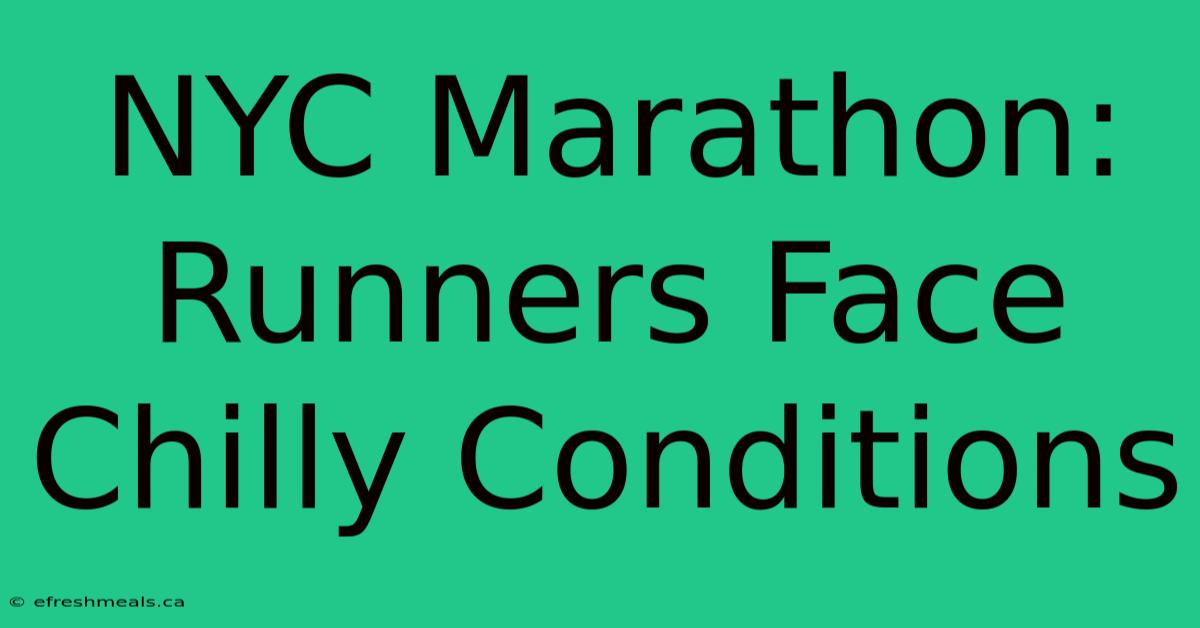NYC Marathon: Runners Face Chilly Conditions

Discover more detailed and exciting information on our website. Click the link below to start your adventure: Visit Best Website nimila.me. Don't miss out!
Table of Contents
NYC Marathon: Runners Face Chilly Conditions, But Spirits Remain High
Editor’s Note: The 2023 NYC Marathon is underway! Despite a chilly start, the spirit of the runners remains strong.
Why It Matters: The New York City Marathon is one of the world's most iconic races, attracting thousands of participants and spectators each year. This year's event saw a unique challenge for runners: unseasonably cool temperatures for a late autumn race. Understanding the impact of weather conditions on runners is crucial for both participant safety and performance.
Key Takeaways of NYC Marathon:
| Takeaway | Description |
|---|---|
| Chilly Start: Temperatures were significantly below average for the race, impacting runner performance and safety. | |
| Strategic Warm-Up: Runners adapted with additional layers and extended warm-ups to combat the cold. | |
| Support Crew: Supporters provided extra warmth and encouragement along the route, contributing to the overall positive atmosphere. |
NYC Marathon: A Cold Start to a Warm Race
The 2023 NYC Marathon saw a uniquely cold start for runners. The race, traditionally held in late autumn, typically enjoys relatively mild conditions. However, this year's event saw temperatures significantly below average, with a chilly wind adding to the challenge.
The Impact of Cold:
- Performance: The cold weather can impact muscle performance, potentially leading to a slower race time.
- Safety: Runners are at risk of hypothermia in cold conditions, particularly if they become wet from sweat.
- Mental Toughness: The cold can be mentally challenging, requiring a higher level of focus and determination.
Strategies for Cold-Weather Running:
- Warm-Up: An extended warm-up is crucial for preparing the body for cold conditions. Stretching and dynamic movements help increase blood flow and raise core temperature.
- Proper Clothing: Layering is key. Runners should start with a base layer for moisture management, followed by insulating layers, and a windproof outer layer.
- Hydration: Staying hydrated is essential, even in colder weather. Runners should drink fluids regularly throughout the race to prevent dehydration.
- Mental Preparation: It's important to be mentally prepared for the challenges of cold-weather running. Visualization and positive self-talk can help maintain focus and motivation.
The Importance of Support:
The cheering crowds and support crews played a crucial role in helping runners navigate the cold conditions. Warm drinks and encouragement provided by supporters along the route were invaluable in keeping runners energized and motivated.
Support Crew: A Vital Role
The support crew's role in cold weather is even more significant. Supporters are encouraged to provide:
- Warm Blankets: A warm blanket can help runners quickly regain their core temperature after crossing the finish line.
- Warm Drinks: Hot chocolate, tea, or even warm water can help the body recover from the cold.
- Additional Clothing: If a runner becomes too cold, a support crew can provide additional layers for warmth.
FAQ
Q: What are the recommended temperatures for running in cold weather?
A: Generally, temperatures below 40°F (4°C) are considered cold-weather running conditions. However, individual tolerances vary, and runners should adjust their preparations accordingly.
Q: What are some signs of hypothermia?
A: Signs of hypothermia include shivering, slurred speech, confusion, drowsiness, and loss of coordination. If you experience these symptoms, seek medical attention immediately.
Q: What should I do if I feel cold during the race?
A: If you feel cold during the race, stop at an aid station and warm yourself up. Seek out a support crew member for assistance.
Tips for Cold-Weather Running
- Prioritize Warm-Up: A 20-30 minute warm-up is crucial for cold-weather running.
- Dress in Layers: Layering allows you to adjust your clothing as you warm up.
- Protect Exposed Skin: Wear a hat, gloves, and scarf to protect your face, hands, and ears.
- Stay Hydrated: Drink fluids regularly, even in cold weather.
- Listen to Your Body: If you feel too cold or unwell, stop running and seek medical attention.
Summary of the NYC Marathon
The 2023 NYC Marathon saw a chilly start but the spirit of the runners remained strong. Despite the challenging conditions, participants successfully adapted their strategies, and the support of the crowd and support crews made a significant difference. This year's race showcased the importance of cold-weather running preparedness and the resilience of the human spirit.
Closing Message: Whether you're an experienced marathoner or a first-time runner, remember to prioritize safety and preparation when running in cold weather. The NYC Marathon serves as a reminder that with the right approach, any challenge can be overcome.

Thank you for visiting our website wich cover about NYC Marathon: Runners Face Chilly Conditions. We hope the information provided has been useful to you. Feel free to contact us if you have any questions or need further assistance. See you next time and dont miss to bookmark.
Featured Posts
-
Watch F1 Brazilian Gp Live Tv And Streaming
Nov 04, 2024
-
Vision Pro Reaches Two More Countries
Nov 04, 2024
-
Harris On Snl Election Eve
Nov 04, 2024
-
New York Marathon 2024 Map Closures Start Times
Nov 04, 2024
-
Oklahoma City Storm Damage Reports
Nov 04, 2024
